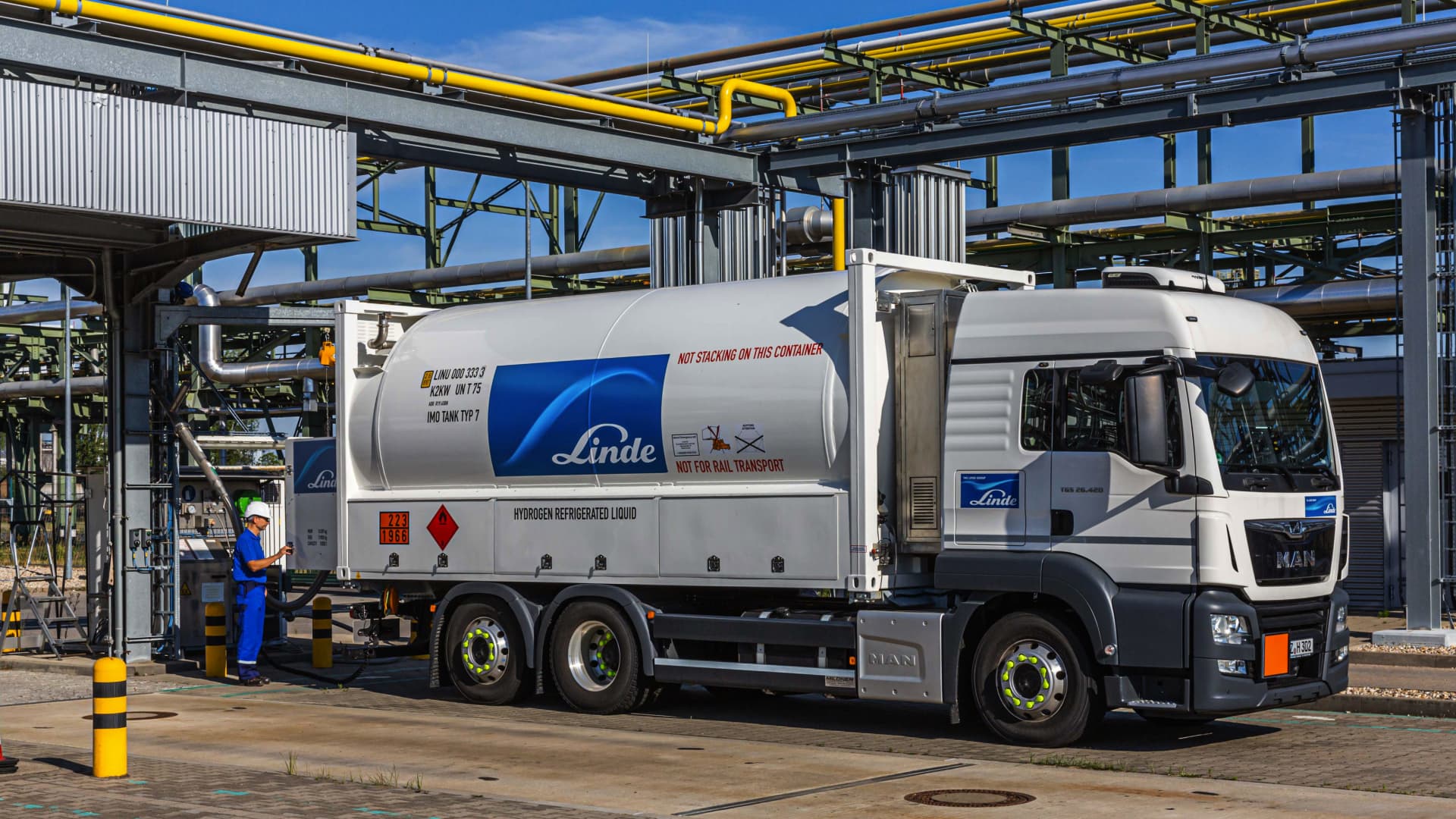Linde ‘s earnings Thursday was a great example of why investors should always wait to hear from management before making any moves. Shares of the industrial gas giant fell after delivering a softer forecast than Wall Street expected — and is accustomed to. But the stock clawed its way back up during the post-earnings call once investors better understood management’s outlook, including some conservatism embedded in the assumptions. Revenue in the fourth quarter dipped 0.2% to $8.28 billion, slightly missing estimates of $8.4 billion expected by analysts, according to estimates compiled by LSEG. Adjusted earnings per share (EPS) increased 0.8% year over year to $3.97, topping expectations by 4 cents, LSEG data showed. Linde (LIN) Why we own it: The industrial gas supplier and engineering firm has a stellar track record of consistent earnings growth. Its exposure to a wide range of industries, such as health care and electronics, and geographies — paired with excellent executive leadership and disciplined capital management — has been a recipe for steady success that should continue. Competitors: Air Liquid and Air Products Most recent buy : Dec. 18, 2024 Initiated : Feb. 18, 2021 Bottom line Linde shares have had a volatile Thursday. The stock traded lower for most of pre-market trading and fell as low as $450 per share around the opening bell in immediate reaction to the 2025 forecast. However, the stock has fought its way to positive territory after investors digested the conference call and got a better understanding of management’s outlook. Indeed, Linde’s forecasted earnings growth for 2025 is below the 10% we’re used to seeing the company put up year in and year out. But the company isn’t benefiting from volume growth, with management estimating a base volume range of negative 2% to 2% for this year. Additionally, currency is a significant headwind, dragging earnings down by an estimated 4% this year. However, management was quick to remind investors that this is simply a forecast and doesn’t reflect potential incremental pricing opportunities to offset these headwinds. “Historically, large currency devaluations have often been followed by periods of more significant local inflation, with 2022 being a recent example” CFO Matt White said. “If that occurs, I’d anticipate incremental pricing opportunities to recover the currency devaluation impact. These potential pricing opportunities are not baked into the guidance range at this time, since the amount or timing of subsequent inflation is difficult to estimate.” This comment made us feel better about Linde’s outlook being a starting point for the year and not completely hostage to currency fluctuations. Linde may not have control over currency and global industrial production, but the company continues to operate at a high level. The company-wide margin improvement was impressive, expanding to nearly 30% from 27.4%. And the company just wrapped up a year in which it signed a huge number of projects and increased its backlog to over $10 billion. On the call, management was very proud of the 59 small on-site wins Linde signed in 2024. “I get excited about small on-sites because from so many different perspectives, they are actually a perfect way of generating annuity income for this business,” White explained. We reiterate our 1 rating and our $500 price target. LIN 1Y mountain Linde stock 1-year performance Quarterly commentary By end market, food and beverage had the strongest year-over-year sales growth, increasing by 6%. Next was a tie between electronics and manufacturing, both up 4%. Metals and mining increased 2%, while health care and chemicals and energy were both flat. By region, Americas was the bright spot, with sales up 1% year over year, driven by 1% volume growth, a 2% benefit from price and mix, a 3% decline from currency (Brazil, Mexico, and Argentina), and a 1% boost from acquisitions. Margins were strong as well, expanding to nearly 32% thanks to continued price and productivity initiatives. The volume growth was driven by manufacturing, electronics, and chemicals and energy. Europe is a murkier picture. Sales from the Europe, Middle East, and Africa (EMEA) region fell 2% year over year due to a 2% decline in volume, a 3% benefit from price and mix, and a 2% decline from cost pass-through, and a 1% headwind from currency. Despite the soft sales, margins were very strong, increasing 330 basis points from last year due to strong pricing and productivity initiatives. The company expects to see conditions continue to soften, primarily in Western Europe, though Eastern Europe has its challenges, too. The weakness is mostly coming from the cyclical complex, with metals, manufacturing, chemicals, and energy expected to have lower volumes. Resilient end markets are expected to continue to grow. Asia-Pacific missed estimates but still delivered revenue and margin growth. Sales increased 2% year over year, driven by a 1% increase in volumes thanks to project startups, mostly in the electronics industry. There was also a 1% positive impact from cost pass-through. Margins expanded 240 basis points year over year to 30%, driven by what the company described as “good cost management.” For 2025, the company is not forecasting any significant recovery in China. The company expects most sectors in the country to be either stable or down except for the electronics sector, which they said will continue to grow. Outlook For 2025, Linde forecasted adjusted earnings per share in the range of $16.15 to $16.55, representing an increase of 4% to 7% over 2024’s level. The $16.35 midpoint of the outlook range is well below the FactSet consensus estimate of $16.81. One big factor to keep in mind is the impact of the strong U.S. dollar. Linde estimates a 4% year-over-year currency headwind to 2025 EPS. When excluding the impact of currency, Linde’s earnings growth forecast is back in its typical range of 8% to 11%. As usual, the midpoint of Linde’s outlook assumes no economic improvement. That means if the economy does a little better, we would expect earnings at the high end of the range. Should economic conditions worsen, Linde’s earnings could fall toward the bottom end of the range, but we would likely see support from mitigating actions by management and share repurchases. (Jim Cramer’s Charitable Trust is long LIN. See here for a full list of the stocks.) As a subscriber to the CNBC Investing Club with Jim Cramer, you will receive a trade alert before Jim makes a trade. Jim waits 45 minutes after sending a trade alert before buying or selling a stock in his charitable trust’s portfolio. If Jim has talked about a stock on CNBC TV, he waits 72 hours after issuing the trade alert before executing the trade. THE ABOVE INVESTING CLUB INFORMATION IS SUBJECT TO OUR TERMS AND CONDITIONS AND PRIVACY POLICY , TOGETHER WITH OUR DISCLAIMER . NO FIDUCIARY OBLIGATION OR DUTY EXISTS, OR IS CREATED, BY VIRTUE OF YOUR RECEIPT OF ANY INFORMATION PROVIDED IN CONNECTION WITH THE INVESTING CLUB. NO SPECIFIC OUTCOME OR PROFIT IS GUARANTEED.
A liquid hydrogen tanker truck taking a fuel delivery at the Linde hydrogen plant in Leuna, Germany, on Tuesday, July 14, 2020.
Rolf Schulten | Bloomberg | Getty Images
Linde‘s earnings Thursday was a great example of why investors should always wait to hear from management before making any moves.
Shares of the industrial gas giant fell after delivering a softer forecast than Wall Street expected — and is accustomed to. But the stock clawed its way back up during the post-earnings call once investors better understood management’s outlook, including some conservatism embedded in the assumptions.





